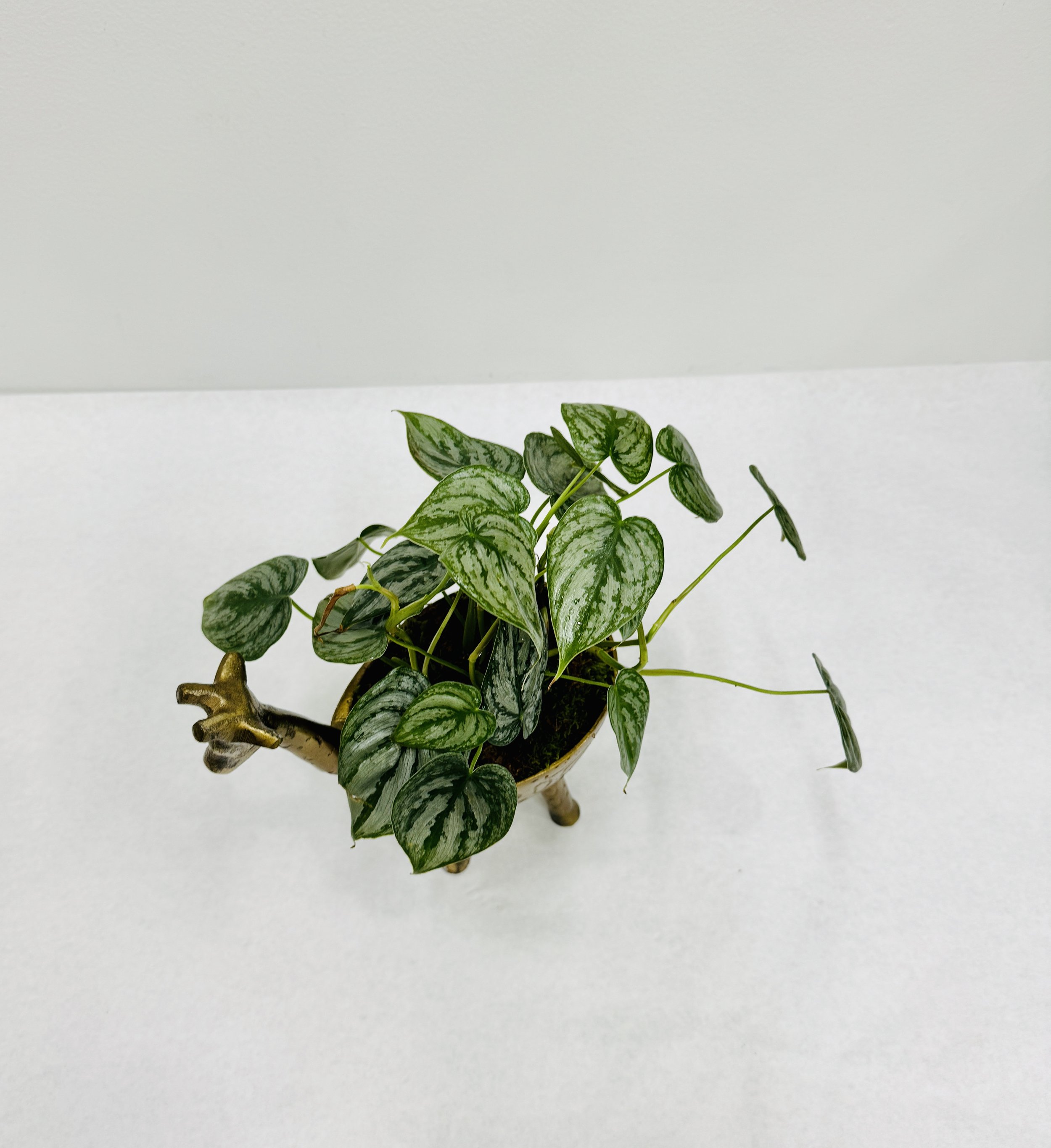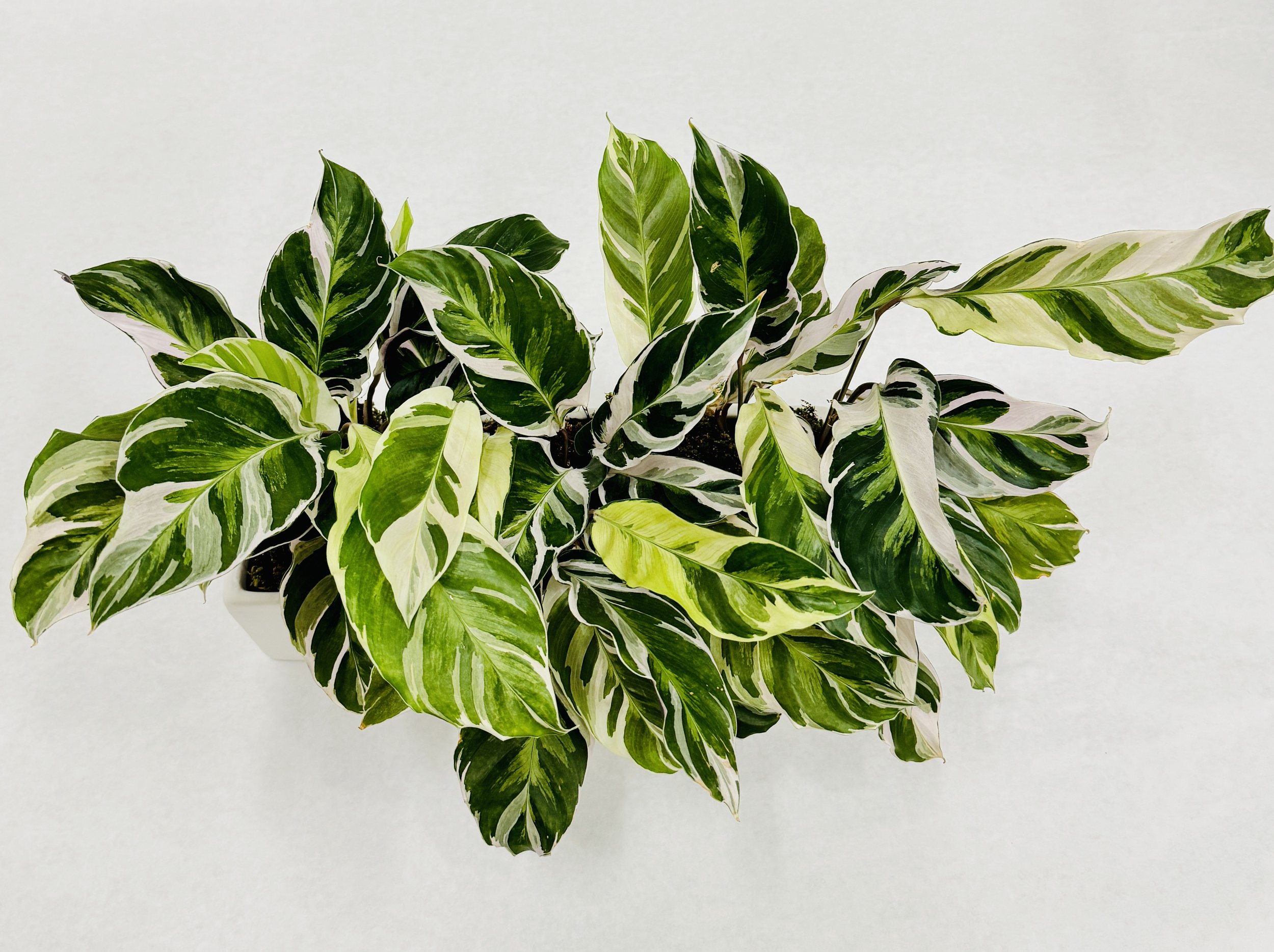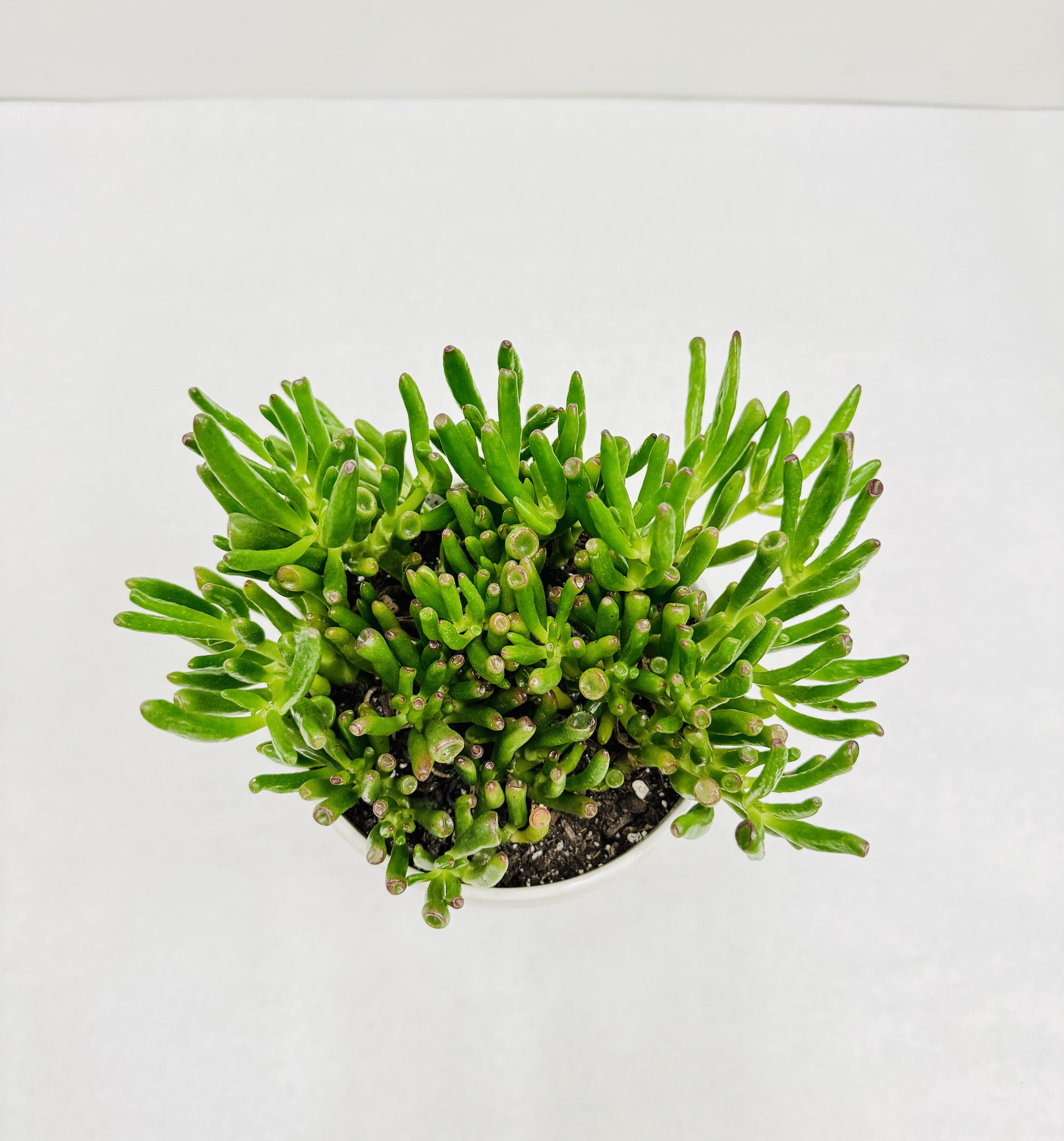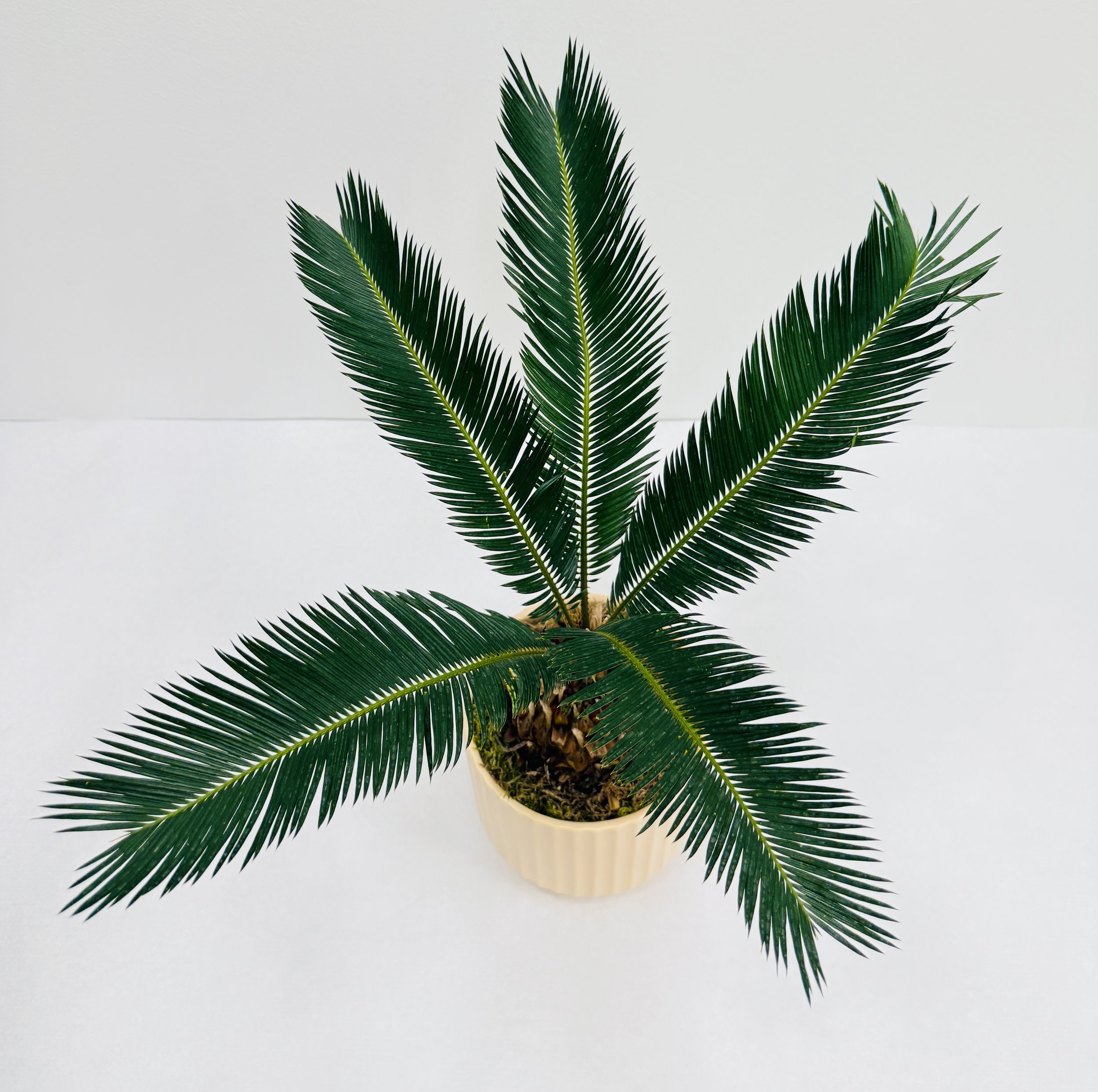Spathiphyllum
1. **Light:** Place the peace lily in bright, indirect light. It can tolerate low light, but it will thrive best with moderate, indirect sunlight.
2. **Watering:** Water the plant when the top inch of soil is dry. Peace lilies prefer consistently moist soil but are sensitive to overwatering. Ensure the pot has good drainage to prevent root rot.
3. **Humidity:** Peace lilies enjoy high humidity.
4. **Temperature:** Keep the peace lily in a warm environment, ideally between 65-80°F
5. **Fertilizing:** Feed the plant with a balanced, water-soluble fertilizer every 6-8 weeks during the growing season (spring and summer). Avoid over-fertilizing, as this can cause brown leaf tips.
6. **Cleaning:** Wipe the leaves occasionally with a damp cloth to remove dust and improve the plant's ability to photosynthesize.
7. **Pruning:** Remove any yellowing or dead leaves to keep the plant healthy and encourage new growth.
Tillandsia Xerographica
1. **Light:** Place your Xerographica in bright, indirect light.
2. **Watering:** Mist your Xerographica 2-3 times a week, ensuring it gets enough moisture. Alternatively, you can soak it in water for 20-30 minutes once every 1-2 weeks. After soaking, shake off any excess water and allow it to dry completely before returning it to its display spot.
3. **Air Circulation:** Ensure good air circulation around the plant. Xerographicas thrive in well-ventilated areas.
4. **Humidity:** While they can tolerate dry conditions, they prefer moderate humidity.
5. **Temperature:** Keep the plant in a warm environment, ideally between 60-80°F Avoid placing it near drafts, heating vents, or air conditioners.
6. **Feeding:** Fertilize your Xerographica once a month during the growing season (spring and summer) with a diluted, balanced, water-soluble fertilizer.
7. **Cleaning:** Remove any dead or damaged leaves to keep the plant healthy. Gently tug on the leaves to remove them.
8. **Display:** Xerographicas do well when mounted on decorative items like driftwood or placed in terrariums that allow for air circulation.
Philodendron Brandi
1. **Light:** Place your Philodendron Brandi in bright, indirect light. It can tolerate lower light conditions but will grow more vigorously in brighter light. Avoid direct sunlight, which can scorch the leaves.
2. **Watering:** Water the plant when the top inch of soil feels dry.
3. **Humidity:** This plant thrives in high humidity. If the air in your home is dry, increase humidity by misting the plant regularly.
4. **Temperature:** Keep the plant in a warm environment, ideally between 65-80°F
5. **Soil:** Use a well-draining, peat-based potting mix.
6. **Fertilizing:** Feed the plant with a balanced, water-soluble fertilizer every 4-6 weeks during the growing season (spring and summer).
7. **Pruning:** Trim any yellow or damaged leaves to maintain the plant's health and appearance.
8. **Support:** As a vining plant, Philodendron Brandi may benefit from a support structure like a moss pole or trellis to climb.
9. **Repotting:** Repot the plant every 1-2 years or when it becomes root-bound.
Calathea Fusion White
1. **Light**: Calathea 'Fusion White' prefers bright, indirect light.
2. **Watering**: Keep the soil consistently moist but not waterlogged. Water when the top inch of soil feels dry, and ensure proper drainage to prevent root rot.
3. **Humidity**: This plant thrives in high humidity environments. Aim for 60% humidity or higher.
4. **Temperature**: Maintain a temperature range of 65-75°F. Avoid cold drafts and sudden temperature changes.
5. **Soil**: Use a well-draining, peat-based potting mix.
6. **Fertilization**: Feed the plant with a balanced, water-soluble fertilizer every 4-6 weeks during the growing season (spring and summer). Reduce feeding during the fall and winter months.
7. **Pruning**: Remove any yellow or brown leaves to maintain the plant's appearance and health.
8. **Pests**: Watch out for common pests like spider mites, mealybugs, and aphids. Treat infestations promptly with insecticidal soap or neem oil.
9. **Repotting**: Repot the plant every 1-2 years or when it becomes root-bound.
Whale Fin
1. **Light**: Place the plant in bright, indirect light. It can tolerate lower light conditions.
2. **Watering**: Water the plant thoroughly when the soil is completely dry. Overwatering can lead to root rot, so it's better to underwater than overwater.
3. **Soil**: Use a well-draining soil mix, such as a cactus or succulent mix.
4. **Temperature**: Keep the plant in a warm environment, ideally between 60-85°F. Protect it from cold drafts and temperatures below 50°F
5. **Humidity**: This plant is not particularly sensitive to humidity and does well in average indoor humidity levels.
6. **Fertilizing**: Feed the plant with a balanced, water-soluble fertilizer diluted to half strength every 4-6 weeks during the growing season (spring and summer).
7. **Potting**: Repot the plant when it outgrows its current pot, usually every 2-3 years.
8. **Pruning**: Remove any yellow or damaged leaves.
Crassula Ovata
1. **Light**: Place the jade plant in a spot where it gets plenty of bright, indirect sunlight. It can also tolerate direct sunlight for a few hours daily.
2. **Watering**: Allow the soil to dry out completely between waterings.
3. **Soil**: Use well-draining soil, such as a cactus or succulent mix.
4. **Temperature**: Jade plants prefer temperatures between 65-75°F during the day and slightly cooler at night.
5. **Humidity**: They do well in typical household humidity levels and don't require additional humidity.
6. **Fertilizing**: Fertilize once a month during the growing season (spring and summer) with a balanced, water-soluble fertilizer diluted to half strength.
7. **Pruning**: Prune to maintain shape and remove any dead or damaged branches.
8. **Repotting**: Repot every 2-3 years or when the plant outgrows its pot.
9. **Pests**: Watch out for pests like mealybugs, spider mites, and scale. Treat infestations promptly with insecticidal soap or neem oil.
Chamaedorea Parlor
1. **Light**: Prefers bright, indirect light but can tolerate lower light conditions. Avoid direct sunlight as it can scorch the leaves.
2. **Watering**: Keep the soil consistently moist but not waterlogged. Overwatering can lead to root rot.
3. **Humidity**: Prefers higher humidity levels. Mist the leaves regularly or place a humidifier nearby, especially in dry environments.
4. **Temperature**: Thrives in temperatures between 65-80°F. Protect it from cold drafts and sudden temperature changes.
5. **Soil**: Use well-draining, peat-based potting soil. A mix designed for palms or houseplants works well.
6. **Fertilizing**: Feed with a balanced liquid fertilizer every 2-4 weeks during the growing season (spring and summer)
7. **Pruning**: Remove yellow or dead fronds at the base using clean, sharp scissors or pruning shears. This helps keep the plant looking neat and encourages new growth.
8. **Repotting**: Repot every 2-3 years or when the plant outgrows its pot.
9. **Pests**: Watch out for spider mites, mealybugs, and scale. Treat infestations with insecticidal soap or neem oil.
10. **General Care**: Wipe the leaves occasionally with a damp cloth to remove dust, allowing the plant to photosynthesize more efficiently.
Ficus Lyrata
1. **Light**: Fiddle leaf figs prefer bright, indirect light. Place them near a window where they can receive plenty of filtered sunlight, but avoid direct sunlight which can burn the leaves.
2. **Watering**: Water your fiddle leaf fig when the top 1-2 inches of soil are dry. Overwatering can lead to root rot, while underwatering can cause the leaves to drop
3. **Humidity**: Fiddle leaf figs thrive in high humidity. Mist the leaves regularly or use a humidifier to maintain a humid environment.
4. **Temperature**: Keep the plant in a stable environment with temperatures between 60-75°F. Avoid placing it near drafts, heaters, or air conditioners.
5. **Soil**: Use well-draining potting soil. A mix designed for houseplants or one that includes peat moss, pine bark, and perlite is ideal.
6. **Fertilizing**: Feed the plant with a balanced, water-soluble fertilizer every month during the growing season (spring and summer).
7. **Pruning**: Trim any dead or damaged leaves to maintain the plant's health and appearance.
8. **Pest Control**: Keep an eye out for pests like spider mites, mealybugs, and scale. Treat infestations promptly with insecticidal soap or neem oil.
Scindapsus Exotic
1. **Light**: Provide bright, indirect light. It can tolerate low light but will grow slower and have less vibrant leaves.
2. **Water**: Allow the top inch of soil to dry out between waterings.
3. **Humidity**: Prefers high humidity but can tolerate average household humidity.
4. **Temperature**: Thrives in temperatures between 65-85°F. Protect it from drafts and sudden temperature changes.
5. **Soil**: Use well-draining soil, such as a mix of peat moss and perlite or a standard indoor potting mix with added perlite.
6. **Fertilizer**: Feed monthly during the growing season (spring and summer) with a balanced liquid fertilizer diluted to half strength.
7. **Pruning**: Prune to maintain desired shape and encourage bushier growth. Cut back any leggy or overgrown vines.
8. **Repotting**: Repot every 2-3 years or when the plant becomes root-bound.
9. **Pests**: Watch for common houseplant pests like spider mites, mealybugs, and aphids. Treat with insecticidal soap or neem oil if needed.
Sago Palm
Light: • Prefers bright, indirect light but can tolerate some direct sun.
• Can adapt to lower light indoors but grows best with at least a few hours of sunlight.
Watering: • Water sparingly—allow the top few inches of soil to dry out between waterings.
• Overwatering can lead to root rot, so ensure the pot has good drainage.
• Reduce watering in winter when growth slows down.
Soil: • Use well-draining soil, such as a cactus or palm mix.
• If planting in the ground, make sure the soil is sandy or loamy with good drainage.
Temperature & Humidity:
• Thrives in warm temperatures (65–85°F).
• Can tolerate brief cold down to 20°F but should be protected from frost.
• Prefers moderate humidity but adapts well to indoor environments.
Nerve Plant (Fittonia)
1. **Light**: Place in bright, indirect light. Avoid direct sunlight, as it can scorch the leaves.
2. **Watering**: Keep the soil consistently moist but not soggy. Water when the top inch of soil feels dry.
3. **Humidity**: Red Fittonia thrives in high humidity. Mist the plant regularly or place it in a humid environment, like a bathroom, or use a humidifier.
4. **Temperature**: Maintain a temperature between 60-80°F. Avoid cold drafts and sudden temperature changes.
5. **Soil**: Use a well-draining potting mix rich in organic matter. A mix designed for African violets works well.
6. **Fertilizer**: Feed with a balanced, water-soluble fertilizer diluted to half strength once a month during the growing season (spring and summer).
7. **Pruning**: Trim back leggy growth to encourage a bushier plant and remove any dead or yellowing leaves.
8. **Repotting**: Repot every 1-2 years to refresh the soil and provide more space for growth.
Dracaena Trifasciata
1. **Light**: Snake plants thrive in indirect sunlight but can tolerate low light conditions. They can also handle some direct sunlight.
2. **Watering**: Water sparingly. Let the soil dry out completely between waterings.
3. **Soil**: Use well-draining soil, such as a cactus or succulent mix.
4. **Temperature**: Snake plants prefer temperatures between 60-75°F. They can tolerate lower temperatures but should be protected from frost.
5. **Humidity**: Average room humidity is sufficient.
6. **Fertilizing**: Fertilize once a month during the growing season (spring and summer)
7. **Potting**: Snake plants like to be slightly root-bound, so you don’t need to repot often. Repotting every 2-3 years is usually sufficient.
8. **Pruning**: Remove any dead or damaged leaves at the base with a clean, sharp knife or scissors.
9. **Pests**: Keep an eye out for pests like spider mites and mealybugs. Wipe the leaves with a damp cloth to keep them clean and reduce pest infestations.
Succulents
1. **Light**: Place succulents in bright, indirect light. A south-facing window is ideal.
2. **Watering** Water when the soil is completely dry. In general, this means every 1-2 weeks during the growing season (spring and summer) and less frequently in winter.
3. **Soil**; Use a well-draining soil mix specifically designed for cacti and succulents.
4. **Containers**: Use pots with drainage holes to prevent water from pooling at the bottom and causing root rot.
5. **Temperature**: Succulents prefer temperatures between 60-80°F. Protect them from frost, as most are not frost-tolerant.
6. **Humidity**:Succulents do well in low humidity environments.
7. **Fertilizing**:Fertilize sparingly. Use a balanced, water-soluble fertilizer diluted to half strength.
8. **Pests**:Common pests include mealybugs, aphids, and spider mites. Regularly inspect your plants and treat infestations with insecticidal soap or neem oil.
9. **Propagation**:Many succulents can be easily propagated from leaves or cuttings.
10. **Pruning**:Remove dead or yellowing leaves to encourage new growth.













